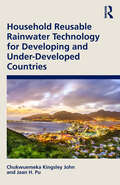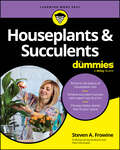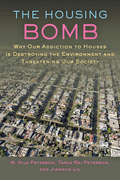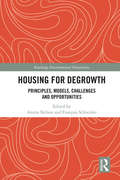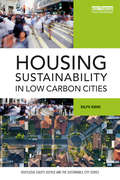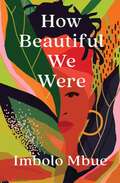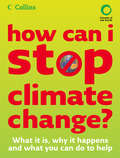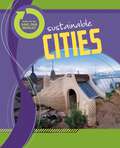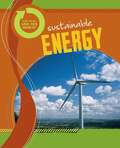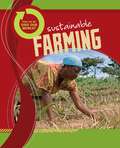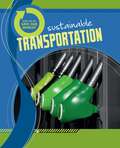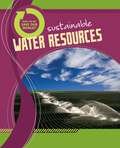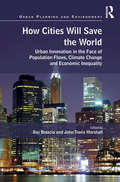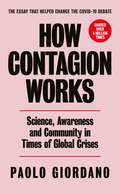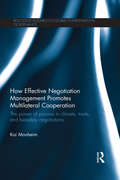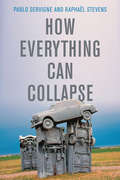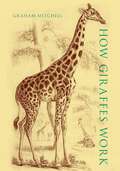- Table View
- List View
Household Reusable Rainwater Technology for Developing and Under-Developed Countries
by Chukwuemeka Kingsley John Jaan H. PuHousehold Reusable Rainwater Technology for Developing and Under-Developed Countries provides insight into household techniques for collecting and treating harvested rainwater safely for both potable and nonpotable uses, as well as practices to improve its quality, with numerous realworld case studies and data. It gives a comprehensive, holistic account on the household scale for both developing and under-developed countries. Improvement mechanisms such as the impacts of first flush, household water treatment techniques, and sedimentation in the harvested water are described in depth together with the advantages and disadvantages of their common practices in developing and under-developed societies. Also discussed is a comprehensive survey illustrating the impact of rainwater sources on the daily life of a carefully selected community from the perspective of its residents. The book is ideal for students, researchers, academics, water policy providers, and bodies worldwide such as WHO and DFID.
Household Reusable Rainwater Technology for Developing and Under-Developed Countries
by Chukwuemeka Kingsley John Jaan H. PuHousehold Reusable Rainwater Technology for Developing and Under-Developed Countries provides insight into household techniques for collecting and treating harvested rainwater safely for both potable and nonpotable uses, as well as practices to improve its quality, with numerous realworld case studies and data. It gives a comprehensive, holistic account on the household scale for both developing and under-developed countries. Improvement mechanisms such as the impacts of first flush, household water treatment techniques, and sedimentation in the harvested water are described in depth together with the advantages and disadvantages of their common practices in developing and under-developed societies. Also discussed is a comprehensive survey illustrating the impact of rainwater sources on the daily life of a carefully selected community from the perspective of its residents. The book is ideal for students, researchers, academics, water policy providers, and bodies worldwide such as WHO and DFID.
Houseplants & Succulents For Dummies
by Steven A. FrowineBecome the best plant parent you can be Houseplant hysteria is here to stay. For new and seasoned plant owners alike, Houseplants & Succulents For Dummies is the ideal resource on plant care, growing cycles, unique plant varieties, and all the essentials you need to know about your rooted friends. Ensure that your sprouts grow and thrive, with tons of tips and answers to all your questions. Are they getting enough light? Are you overwatering? Why are the leaves turning yellow? This fun Dummies guide teaches you to find the right plants for your personal plant care style, identify common varieties, choose the right potting soil, and pick the perfect little nook for your leaf baby. You’ll also learn how to rescue your plants when pests and diseases strike, and even how to use plants as part of a stylish home décor approach. Get growing! Learn about the different types of plants and choose the ones that will work for you Figure out how to keep your plants happy—and what to do about it if they’re not Determine how often to water plants, what type of soil they need, and how much light Improve your mental and respiratory health by filling your home with plantsGrab this handy book if you’re new to the houseplant craze and want a user-friendly, comprehensive guide on plant care. Intermediate and advanced plant parents will also love this handy reference with info on the latest plant trends and new varieties.
Houseplants & Succulents For Dummies
by Steven A. FrowineBecome the best plant parent you can be Houseplant hysteria is here to stay. For new and seasoned plant owners alike, Houseplants & Succulents For Dummies is the ideal resource on plant care, growing cycles, unique plant varieties, and all the essentials you need to know about your rooted friends. Ensure that your sprouts grow and thrive, with tons of tips and answers to all your questions. Are they getting enough light? Are you overwatering? Why are the leaves turning yellow? This fun Dummies guide teaches you to find the right plants for your personal plant care style, identify common varieties, choose the right potting soil, and pick the perfect little nook for your leaf baby. You’ll also learn how to rescue your plants when pests and diseases strike, and even how to use plants as part of a stylish home décor approach. Get growing! Learn about the different types of plants and choose the ones that will work for you Figure out how to keep your plants happy—and what to do about it if they’re not Determine how often to water plants, what type of soil they need, and how much light Improve your mental and respiratory health by filling your home with plantsGrab this handy book if you’re new to the houseplant craze and want a user-friendly, comprehensive guide on plant care. Intermediate and advanced plant parents will also love this handy reference with info on the latest plant trends and new varieties.
The Housing Bomb: Why Our Addiction to Houses Is Destroying the Environment and Threatening Our Society
by Jianguo Liu M. Nils Peterson Tarla PetersonHave we built our way to ruin? Is your desire for that beach house or cabin in the woods part of the environmental crisis? Do you really need a bigger home? Why don’t multiple generations still live under one roof? In The Housing Bomb, leading environmental researchers M. Nils Peterson, Tarla Rai Peterson, and Jianguo Liu sound the alarm, explaining how and why our growing addiction to houses has taken the humble American dream and twisted it into an environmental and societal nightmare. Without realizing how much a contemporary home already contributes to environmental destruction, most of us want bigger and bigger houses and dream of the day when we own not just one dwelling but at least the two our neighbor does. We push our children to "get out on their own" long before they need to, creating a second household where previously one existed. We pave and build, demolishing habitat needed by threatened and endangered species, adding to the mounting burden of global climate change, and sucking away resources much better applied to pressing societal needs. "Reduce, reuse, recycle" is seldom evoked in the housing world, where economists predict financial disasters when "new housing starts" decline and the idea of renovating inner city residences is regarded as merely a good cause. Presenting irrefutable evidence, this book cries out for America and the world to intervene by making simple changes in our household energy and water usage and by supporting municipal, state, national, and international policies to counter this devastation and overuse of resources. It offers a way out of the mess we are creating and envisions a future where we all live comfortable, nondestructive lives. The "housing bomb" is ticking, and our choice is clear—change our approach or feel the blast.
The Housing Bomb: Why Our Addiction to Houses Is Destroying the Environment and Threatening Our Society
by M. Nils Peterson Tarla Peterson Jianguo LiuHave we built our way to ruin? Is your desire for that beach house or cabin in the woods part of the environmental crisis? Do you really need a bigger home? Why don’t multiple generations still live under one roof? In The Housing Bomb, leading environmental researchers M. Nils Peterson, Tarla Rai Peterson, and Jianguo Liu sound the alarm, explaining how and why our growing addiction to houses has taken the humble American dream and twisted it into an environmental and societal nightmare. Without realizing how much a contemporary home already contributes to environmental destruction, most of us want bigger and bigger houses and dream of the day when we own not just one dwelling but at least the two our neighbor does. We push our children to "get out on their own" long before they need to, creating a second household where previously one existed. We pave and build, demolishing habitat needed by threatened and endangered species, adding to the mounting burden of global climate change, and sucking away resources much better applied to pressing societal needs. "Reduce, reuse, recycle" is seldom evoked in the housing world, where economists predict financial disasters when "new housing starts" decline and the idea of renovating inner city residences is regarded as merely a good cause. Presenting irrefutable evidence, this book cries out for America and the world to intervene by making simple changes in our household energy and water usage and by supporting municipal, state, national, and international policies to counter this devastation and overuse of resources. It offers a way out of the mess we are creating and envisions a future where we all live comfortable, nondestructive lives. The "housing bomb" is ticking, and our choice is clear—change our approach or feel the blast.
Housing for Degrowth: Principles, Models, Challenges and Opportunities (Routledge Environmental Humanities)
by Anitra Nelson François Schneider‘Degrowth’, a type of ‘postgrowth’, is becoming a strong political, practical and cultural movement for downscaling and transforming societies beyond capitalist growth and non-capitalist productivism to achieve global sustainability and satisfy everyone’s basic needs. This groundbreaking collection on housing for degrowth addresses key challenges of unaffordable, unsustainable and anti-social housing today, including going beyond struggles for a 'right to the city' to a 'right to metabolism', advocating refurbishment versus demolition, and revealing controversies within the degrowth movement on urbanisation, decentralisation and open localism. International case studies show how housing for degrowth is based on sufficiency and conviviality, living a ‘one planet lifestyle’ with a common ecological footprint. This book explores environmental, cultural and economic housing and planning issues from interdisciplinary perspectives such as urbanism, ecological economics, environmental justice, housing studies and policy, planning studies and policy, sustainability studies, political ecology, social change and degrowth. It will appeal to students and scholars across a wide range of disciplines.
Housing for Degrowth: Principles, Models, Challenges and Opportunities (Routledge Environmental Humanities)
by Anitra Nelson François Schneider‘Degrowth’, a type of ‘postgrowth’, is becoming a strong political, practical and cultural movement for downscaling and transforming societies beyond capitalist growth and non-capitalist productivism to achieve global sustainability and satisfy everyone’s basic needs. This groundbreaking collection on housing for degrowth addresses key challenges of unaffordable, unsustainable and anti-social housing today, including going beyond struggles for a 'right to the city' to a 'right to metabolism', advocating refurbishment versus demolition, and revealing controversies within the degrowth movement on urbanisation, decentralisation and open localism. International case studies show how housing for degrowth is based on sufficiency and conviviality, living a ‘one planet lifestyle’ with a common ecological footprint. This book explores environmental, cultural and economic housing and planning issues from interdisciplinary perspectives such as urbanism, ecological economics, environmental justice, housing studies and policy, planning studies and policy, sustainability studies, political ecology, social change and degrowth. It will appeal to students and scholars across a wide range of disciplines.
Housing Sustainability in Low Carbon Cities (Routledge Equity, Justice and the Sustainable City series)
by Ralph HorneHousing affordability, urban development and climate change responses are great challenges that are intertwined, yet the conceptual and policy links between them remain under-developed. Housing Sustainability in Low Carbon Cities addresses this gap by developing an interdisciplinary approach to urban decarbonisation, drawing upon more established, yet quite distinctive, fields of built environment policy and design, housing, and studies of social and economic change. Through this approach, policy and practices of housing affordability, equity, energy efficiency, resilience and renewables are critiqued and alternatives are presented. Drawing upon international case studies, this book provides a unique contribution to interdisciplinary urban and housing studies, discourses and practices in an era of climate change. This book is recommended reading on higher level undergraduate and taught postgraduate courses in architecture, urban studies, planning, built environment, geography and urban studies. It will also be directly valuable to housing and urban policy makers and sustainability practitioners.
Housing Sustainability in Low Carbon Cities (Routledge Equity, Justice and the Sustainable City series)
by Ralph HorneHousing affordability, urban development and climate change responses are great challenges that are intertwined, yet the conceptual and policy links between them remain under-developed. Housing Sustainability in Low Carbon Cities addresses this gap by developing an interdisciplinary approach to urban decarbonisation, drawing upon more established, yet quite distinctive, fields of built environment policy and design, housing, and studies of social and economic change. Through this approach, policy and practices of housing affordability, equity, energy efficiency, resilience and renewables are critiqued and alternatives are presented. Drawing upon international case studies, this book provides a unique contribution to interdisciplinary urban and housing studies, discourses and practices in an era of climate change. This book is recommended reading on higher level undergraduate and taught postgraduate courses in architecture, urban studies, planning, built environment, geography and urban studies. It will also be directly valuable to housing and urban policy makers and sustainability practitioners.
How Beautiful We Were: A Novel
by Imbolo Mbue'A formidable storyteller' JONATHAN FRANZEN Set in the fictional African village of Kosawa, How Beautiful We Were tells the story of a people living in fear amidst environmental degradation wrought by an American oil company. Pipeline spills have rendered farmlands infertile. Children are dying from drinking toxic water. Promises of clean-up and financial reparations are made – and ignored. The country’s government, led by a brazen dictator, exists to serve its own interest only. Left with few choices, the people of Kosawa decide to fight back. But their fight will come at a steep price . . . one which generation after generation will have to pay. Told through the perspective of a generation of children and the family of a girl named Thula, How Beautiful We Were is a masterful exploration of what happens when the reckless drive for profit, coupled with the ghost of colonialism, comes up against one community’s determination to hold onto its ancestral land and a young woman’s willingness to sacrifice everything for the sake of her people’s freedom.
How Can I Stop Climate Change: What Is It And How To Help
by Friends of the EarthDon’t just sit there, do something. But what? How Can I Stop Climate Change? explains what climate change is and what you can do to stop it. Written by the experts at Friends of the Earth, it gives you the facts and figures and offers practical advice and simple solutions.
How Can We Save Our World? Sustainable Cities (How Can We Save Our World?)
by Angela RoystonHow Can We Save Our World looks at how the idea of sustainable development is having an increasing influence on a wide range of human activities. The books examine the environmental costs and unsustainable nature of modern life, and discuss ways in which society can progress toward a more sustainable future.Sustainable Cities describes the development of cities from earliest times to the mega-cities of today. It discusses:€ The waste and pollution that make our cities unsustainable€ Building techniques that conserve energy and use waste and recycled materials€ Eco-communities that produce their own energy and reduce the need for travel€ How we can make existing cities greener and more sustainable.
How Can We Save Our World? Sustainable Energy (How Can We Save Our World?)
by Angela RoystonHow Can We Save Our World looks at how the idea of sustainable development is having an increasing influence on a wide range of human activities. The books examine the environmental costs and unsustainable nature of modern life, and discuss ways in which society can progress toward a more sustainable future.Sustainable Energy focuses on electricity and the way in which it is generated. It discusses:€ The pollution caused by fossil fuels, and the dwindling resources that make their use unsustainable€ The advantages and disadvantages of nuclear, water, and wind power€ Scientific methods of harnessing sustainable energy, such as solar and geothermal power€ Engineering innovations that can help us reduce the amount of energy we use.
How Can We Save Our World? Sustainable Farming (How Can We Save Our World?)
by Carol BallardHow Can We Save Our World looks at how the idea of sustainable development is having an increasing influence on a wide range of human activities. The books examine the environmental costs and unsustainable nature of modern life, and discuss ways in which society can progress toward a more sustainable future.Sustainable Farming describes the history of farming and explains why we need to make it more sustainable. It discusses:€ The environmental problems created by agriculture€ How the globalization of agriculture means that farm products are transported across the world€ Ways to make farming more sustainable€ How to achieve a balance between the needs of farmers, rural communities, consumers, and businesses.
How Can We Save Our World? Sustainable Tourism (How Can We Save Our World?)
by Andrew SolwayHow Can We Save Our World looks at how the idea of sustainable development is having an increasing influence on a wide range of human activities. The books examine the environmental costs and unsustainable nature of modern life, and discuss ways in which society can progress toward a more sustainable future.Sustainable Tourism describes the development of tourism from Roman times to the multi-million dollar industry of today. It discusses:€ The waste, over-consumption, and pollution that make tourism unsustainable€ Eco-friendly holidays that bring benefits to a region and help people learn about the importance of conservation€ Greenwashing-the abuse of ecotourism by profit-chasing businesses€ What we can do as tourists to conserve resources, benefit local people, and minimize our impact on the environment.
How Can We Save Our World? Sustainable Transportation (How Can We Save Our World?)
by Cath SenkerHow Can We Save Our World looks at how the idea of sustainable development is having an increasing influence on a wide range of human activities. The books examine the environmental costs and unsustainable nature of modern life, and discuss ways in which society can progress toward a more sustainable future.Sustainable Transportation describes the development of modern transportation systems and looks at the impact they have on the environment. It discusses:€ The emissions that make current forms of transportation unsustainable€ Vehicle designs that can improve fuel efficiency and reduce pollution€ Schemes that can reduce traffic congestion and help develop more integrated transportation systems€ Ways to reduce our dependency on polluting transportation methods.
How Can We Save Our World? Sustainable Water Resources (How Can We Save Our World?)
by Anne RooneyHow Can We Save Our World looks at how the idea of sustainable development is having an increasing influence on a wide range of human activities. The books examine the environmental costs and unsustainable nature of modern life, and discuss ways in which society can progress toward a more sustainable future.Sustainable Water Resources describes the origins of the world's water and how we use water in our homes, industries, and agriculture. It discusses:€ The pressures on the water supply today€ How water shortages affect people's lives€ Technological solutions for providing clean water and processing water€ How we can use water more efficiently to ensure there is enough for all.
How Cities Will Save the World: Urban Innovation in the Face of Population Flows, Climate Change and Economic Inequality (Urban Planning and Environment)
by Ray Brescia John Travis MarshallCities are frequently viewed as passive participants to state and national efforts to solve the toughest urban problems. But the evidence suggests otherwise. Cities are actively devising innovative policy solutions and they have the potential to do even more. In this volume, the authors examine current threats to communities across the U.S. and the globe. They draw on first-hand experience with, and accounts of, the crises already precipitated by climate change, population shifts, and economic inequality. This volume is distinguished, however, by its central objective of traveling beyond a description of problems and a discussion of their serious implications. Each of the thirteen chapters frame specific recommendations and guidance on the range of core capacities and interventions that 21st Century cities would be prudent to consider in mapping their immediate and future responses to these critical problems. How Cities Will Save the World brings together authors with frontline experience in the fields of city redevelopment, urban infrastructure, healthcare, planning, immigration, historic preservation, and local government administration. They not only offer their ground level view of threats caused by climate change, population shifts, and economic inequality, but they provide solution-driven narratives identifying promising innovations to help cities tackle this century’s greatest adversities.
How Cities Will Save the World: Urban Innovation in the Face of Population Flows, Climate Change and Economic Inequality (Urban Planning and Environment)
by Ray Brescia John Travis MarshallCities are frequently viewed as passive participants to state and national efforts to solve the toughest urban problems. But the evidence suggests otherwise. Cities are actively devising innovative policy solutions and they have the potential to do even more. In this volume, the authors examine current threats to communities across the U.S. and the globe. They draw on first-hand experience with, and accounts of, the crises already precipitated by climate change, population shifts, and economic inequality. This volume is distinguished, however, by its central objective of traveling beyond a description of problems and a discussion of their serious implications. Each of the thirteen chapters frame specific recommendations and guidance on the range of core capacities and interventions that 21st Century cities would be prudent to consider in mapping their immediate and future responses to these critical problems. How Cities Will Save the World brings together authors with frontline experience in the fields of city redevelopment, urban infrastructure, healthcare, planning, immigration, historic preservation, and local government administration. They not only offer their ground level view of threats caused by climate change, population shifts, and economic inequality, but they provide solution-driven narratives identifying promising innovations to help cities tackle this century’s greatest adversities.
How Contagion Works: Science, Awareness and Community in Times of Global Crises - The essay that helped change the Covid-19 debate
by Paolo GiordanoThe Covid-19 pandemic is the most significant health emergency of our time.Writing from Italy in lockdown, physicist and novelist Paolo Giordano explains how disease spreads in our interconnected world: why it mattershow it impacts ushow we must reactExpanding his focus to include other forms of contagion - from the environmental crisis to fake news and xenophobia - Giordano shows us not just how we got here but also how we can work together to create change.Paolo Giordano is a physicist and the author of four bestselling novels. His article 'The Mathematics of Contagion' - published in Italy at the beginning of the Covid-19 emergency - was shared more than 4 million times and helped shift public opinion in the early stages of the epidemic.
How Effective Negotiation Management Promotes Multilateral Cooperation: The power of process in climate, trade, and biosafety negotiations (Routledge Research in Global Environmental Governance)
by Kai MonheimMultilateral negotiations on worldwide challenges have grown in importance with rising global interdependence. Yet, they have recently proven slow to address these challenges successfully. This book discusses the questions which have arisen from the highly varying results of recent multilateral attempts to reach cooperation on some of the critical global challenges of our times. These include the long-awaited UN climate change summit in Copenhagen, which ended without official agreement in 2009; Cancún one year later, attaining at least moderate tangible results; the first salient trade negotiations after the creation of the WTO, which broke down in Seattle in 1999 and were only successfully launched in 2001 in Qatar as the Doha Development Agenda; and the biosafety negotiations to address the international handling of Living Modified Organisms, which first collapsed in 1999, before they reached the Cartagena Protocol in 2000. Using in-depth empirical analysis, the book examines the determinants of success or failure in efforts to form regimes and manage the process of multilateral negotiations. The book draws on data from 62 interviews with organizers and chief climate and trade negotiators to discover what has driven delegations in their final decision on agreement, finding that with negotiation management, organisers hold a powerful tool in their hands to influence multilateral negotiations. This comprehensive negotiation framework, its comparison across regimes and the rich and first-hand empirical material from decision-makers make this invaluable reading for students and scholars of politics, international relations, global environmental governance, climate change and international trade, as well as organizers and delegates of multilateral negotiations. This research has been awarded the German Mediation Scholarship Prize for 2014 by the Center for Mediation in Cologne.
How Effective Negotiation Management Promotes Multilateral Cooperation: The power of process in climate, trade, and biosafety negotiations (Routledge Research in Global Environmental Governance)
by Kai MonheimMultilateral negotiations on worldwide challenges have grown in importance with rising global interdependence. Yet, they have recently proven slow to address these challenges successfully. This book discusses the questions which have arisen from the highly varying results of recent multilateral attempts to reach cooperation on some of the critical global challenges of our times. These include the long-awaited UN climate change summit in Copenhagen, which ended without official agreement in 2009; Cancún one year later, attaining at least moderate tangible results; the first salient trade negotiations after the creation of the WTO, which broke down in Seattle in 1999 and were only successfully launched in 2001 in Qatar as the Doha Development Agenda; and the biosafety negotiations to address the international handling of Living Modified Organisms, which first collapsed in 1999, before they reached the Cartagena Protocol in 2000. Using in-depth empirical analysis, the book examines the determinants of success or failure in efforts to form regimes and manage the process of multilateral negotiations. The book draws on data from 62 interviews with organizers and chief climate and trade negotiators to discover what has driven delegations in their final decision on agreement, finding that with negotiation management, organisers hold a powerful tool in their hands to influence multilateral negotiations. This comprehensive negotiation framework, its comparison across regimes and the rich and first-hand empirical material from decision-makers make this invaluable reading for students and scholars of politics, international relations, global environmental governance, climate change and international trade, as well as organizers and delegates of multilateral negotiations. This research has been awarded the German Mediation Scholarship Prize for 2014 by the Center for Mediation in Cologne.
How Everything Can Collapse: A Manual for our Times
by Pablo Servigne Raphael StevensWhat if our civilization were to collapse? Not many centuries into the future, but in our own lifetimes? Most people recognize that we face huge challenges today, from climate change and its potentially catastrophic consequences to a plethora of socio-political problems, but we find it hard to face up to the very real possibility that these crises could produce a collapse of our entire civilization. Yet we now have a great deal of evidence to suggest that we are up against growing systemic instabilities that pose a serious threat to the capacity of human populations to maintain themselves in a sustainable environment.In this important book, Pablo Servigne and Raphaël Stevens confront these issues head-on. They examine the scientific evidence and show how its findings, often presented in a detached and abstract way, are connected to people’s ordinary experiences – joining the dots, as it were, between the Anthropocene and our everyday lives. In so doing they provide a valuable guide that will help everyone make sense of the new and potentially catastrophic situation in which we now find ourselves. Today, utopia has changed sides: it is the utopians who believe that everything can continue as before, while realists put their energy into making a transition and building local resilience. Collapse is the horizon of our generation. But collapse is not the end – it’s the beginning of our future. We will reinvent new ways of living in the world and being attentive to ourselves, to other human beings and to all our fellow creatures.
How Giraffes Work
by Graham MitchellThere are few creatures more beautiful, aloof, and fascinating than giraffes. Their social and ecological impact has been documented by many researchers. However, the inner workings of extant giraffes are less well known. That is why Graham Mitchell decided to write How Giraffes Work: a comprehensive overview of the anatomy, physiology, and biochemistry--in short, the normal functions--of a free-living, wild animal in its natural environment. A zoologist, veterinarian, and physiologist, Mitchell explains how giraffes get through their day. Additionally, he takes readers through the evolution of their physical characteristics, such as their size, shape, and coat markings. His approach integrates history with the physiology, anatomy, biochemistry, behavior, evolution, genetics, ecology, climate science, and more. Each chapter follows the discovery and utility of a different characteristic of giraffes. Illustrated with over two hundred figures and diagrams, the book explains how giraffes might have evolved and survived over many millions of years as well as how our perception of them has changed throughout history. So, how do giraffes work? The answers lie in a story filled not only with the details of their internal working but also with the labors of the extraordinary scientists who have put so many pieces of this puzzle together.
